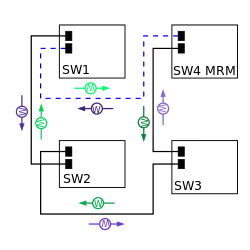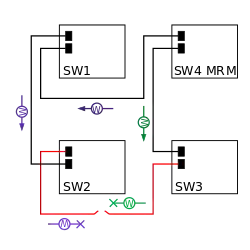Media Redundancy Protocol
Media Redundancy Protocol (MRP) is a data network protocol standardized by the International Electrotechnical Commission as IEC 62439-2. It allows rings of Ethernet switches to overcome any single failure with recovery time much faster than achievable with Spanning Tree Protocol.[1] It is suitable to most Industrial Ethernet applications.


Properties
MRP operates at the MAC layer of Ethernet switches and is a direct evolution of the HiPER-Ring protocol developed by Hirschmann in 1998.[2][3] Hirschmann is now owned by Belden.[4] MRP is supported by several commercial Industrial Ethernet switches.[5][6]
In an MRP ring, the ring manager is named Media Redundancy Manager (MRM), while ring clients are named Media Redundancy Clients (MRCs).
MRM and MRC ring ports support three status: disabled, blocked, and forwarding. Disabled ring ports drop all the received frames. Blocked ring ports drop all the received frames except the MRP control frames. Forwarding ring ports forward all the received frames.
During normal operation, the network works in the Ring-Closed status (Figure 1). In this status, one of the MRM ring ports is blocked, while the other is forwarding. Conversely, both ring ports of all MRCs are forwarding. Loops are avoided because the physical ring topology is reduced to a logical stub topology.
In case of failure, the network works in the Ring-Open status (Figure 2). For instance, in case of failure of a link connecting two MRCs, the MRM sets both of its ring ports to the forwarding state; the MRCs adjacent to the failure each have a blocked and a forwarding ring port; the other MRCs have both ring ports forwarding. Also, in the Ring-Open status, the network logical topology is a stub.
Standards
The International Electrotechnical Commission standard for MRP was published in 2010 as IEC 62439-2[7] and amended in 2012.
The standard IEC 62439 published in 2012 also defined the following protocols:
- Parallel Redundancy Protocol (PRP)
- Cross-network Redundancy Protocol - CRP
- Beacon Redundancy Protocol - BRP
- High-availability Seamless Redundancy (HSR)
With the settings specified in IEC 62439-2, MRP guarantees a worst-case recovery time of 500 ms, 200 ms, or 30 ms in rings composed of up to 50 switches, and a worst-case recovery time of 10 ms in rings composed of up to 14 switches.
References
- A. Giorgetti; et al. (February 3, 2013). "Performance Analysis of Media Redundancy Protocol (MRP)". IEEE Transactions on Industrial Informatics. IEEE Computer Society. 9: 218–227. doi:10.1109/TII.2012.2186584.
- "Hirschmann Networking Interoperability to Industrial/Process and EtherNet/IP Environments" (PDF). White paper. December 8, 2003. Archived from the original (PDF) on May 16, 2008. Retrieved August 17, 2013.
- Marc Lee (November 5, 2010). "Industrial Redundant Network" (PDF). Singapore BICSI conference. Retrieved August 17, 2013.
- "HiOS - Hirschmann™ Operating System". Web site. Hirschmann a Belden Brand. Archived from the original on May 12, 2013. Retrieved August 17, 2013.
- "Fast Ethernet DIN Rail switch 8-9 ports". Product page. Belden. Retrieved August 17, 2013.
- "PROFINET Open Industrial Ethernet standard for automation" (PDF). Omron. October 12, 2009. Archived from the original (PDF) on February 16, 2011. Retrieved August 17, 2013.
- Industrial communication networks - High availability automation networks - Part 2: Media Redundancy Protocol (MRP). IEC 62439-2. February 26, 2010. ISBN 978-2-88912-000-0.